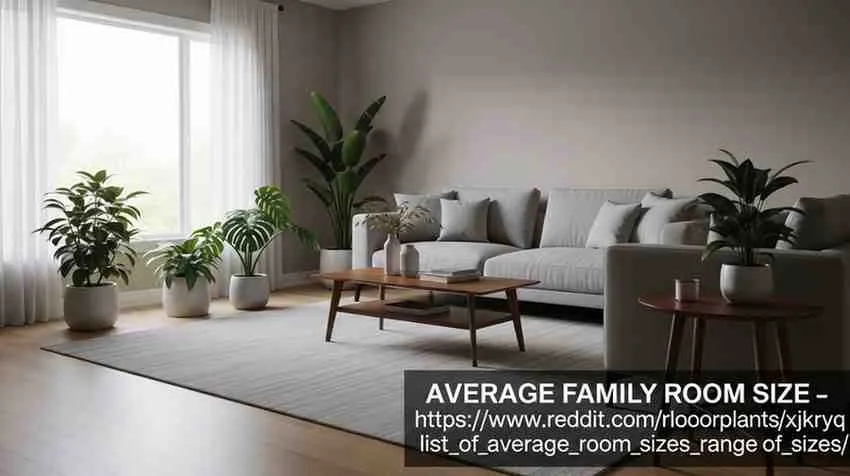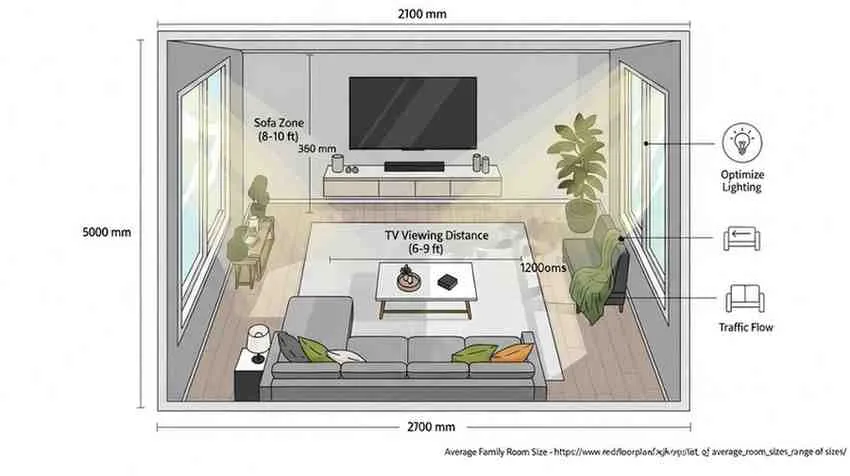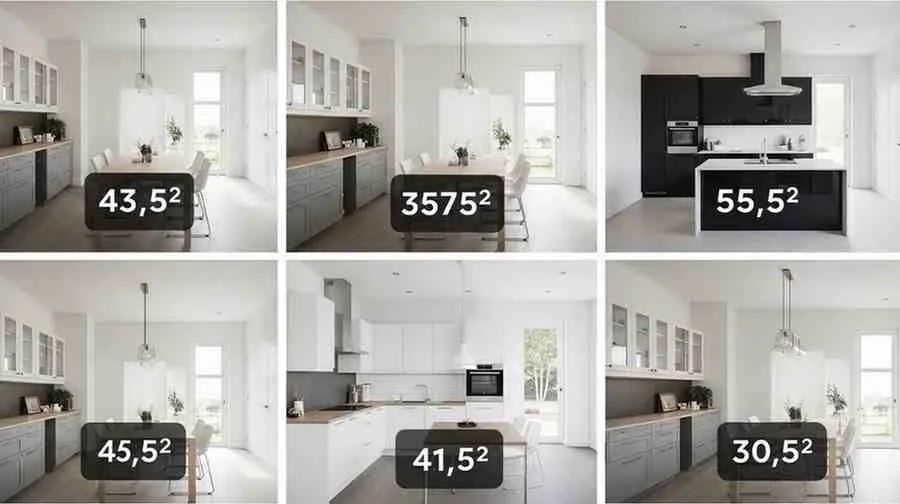Introduction: Finding the Right Size for Your Family’s Heart
Walk into a beautifully designed home, and you’ll notice something immediately—the spaces feel just right. Not too cramped, not cavernously empty, but perfectly proportioned for comfortable living. This magic isn’t accidental; it’s the result of thoughtful planning around standard room dimensions that have evolved over decades of residential design.
Whether you’re building a new home, planning a renovation, or simply trying to understand if your current family room feels unusually small or large, understanding average family room size standards provides invaluable context. These dimensions influence everything from furniture selection and placement to traffic flow, lighting needs, and even your family’s daily comfort and interaction patterns.
The family room has become the true heart of modern homes—the space where families gather for movie nights, children do homework while parents prepare dinner nearby, and weekend mornings unfold with coffee and conversation. Getting the size right matters more than almost any other design decision you’ll make.
This comprehensive guide explores typical family room dimensions across different home styles and price points, examines how room size affects functionality and comfort, and provides practical guidance for planning spaces that work beautifully for your specific needs. You’ll discover industry standards, regional variations, and expert recommendations that will help you make informed decisions whether you’re designing from scratch or working with existing spaces.
From understanding minimum room size codes to planning optimal furniture layouts, we’ll cover everything you need to know about creating family rooms that feel spacious, comfortable, and perfectly suited to how your family actually lives.
Understanding Average Family Room Size: The Numbers That Matter
National Standards and Typical Dimensions
The average family room size in American homes typically ranges from 12×18 feet (216 square feet) to 16×20 feet (320 square feet), depending on the overall home size and regional building practices. However, these numbers tell only part of the story, as family room dimensions vary considerably based on several factors.

According to data from the National Association of Home Builders and architectural standards, here’s what you can expect across different home categories:
Small Homes and Starter Houses (Under 1,500 sq ft total)
- Family room size: 12×14 to 12×16 feet (168-192 square feet)
- These compact dimensions work for smaller families or those who prioritize efficiency
Medium-Sized Homes (1,500-2,500 sq ft total)
- Family room size: 14×18 to 16×20 feet (252-320 square feet)
- This represents the most common family room dimensions in suburban developments
Large Homes (2,500-4,000 sq ft total)
- Family room size: 16×20 to 18×24 feet (320-432 square feet)
- Provides ample space for larger furniture arrangements and multiple activity zones
Luxury and Custom Homes (Over 4,000 sq ft total)
- Family room size: 18×24 feet and up (432+ square feet)
- Often includes vaulted ceilings and opens to other spaces for grand proportions
Standard Living Room Size Versus Family Room
It’s important to distinguish between living rooms and family rooms, as these spaces serve different purposes and typically have different dimensions. Traditional living rooms (formal sitting areas) average slightly smaller at 12×16 to 14×18 feet, while family rooms tend toward 14×18 to 16×20 feet to accommodate more casual, multi-functional use.
The family room typically connects more directly to the kitchen and dining areas in open-concept designs, while living rooms often occupy front-of-house locations as more formal receiving spaces. This functional difference influences not just size but also shape, ceiling height, and connection to other rooms.
Average Room Size Chart for Complete Homes
To put family room dimensions in context, here’s a comprehensive look at typical room sizes throughout a home:
Living Spaces:
- Family room: 14×20 feet (280 sq ft) – medium standard
- Living room: 12×18 feet (216 sq ft) – traditional standard
- Great room (combined living/dining): 16×24 to 20×28 feet (384-560 sq ft)
- Den/Study: 10×12 feet (120 sq ft)
Bedrooms:
- Primary bedroom: 14×16 to 16×18 feet (224-288 sq ft)
- Secondary bedrooms: 11×12 to 12×14 feet (132-168 sq ft)
- Guest bedroom: 10×12 feet (120 sq ft)
Kitchen and Dining:
- Kitchen: 10×12 to 12×16 feet (120-192 sq ft)
- Dining room: 12×14 to 14×16 feet (168-224 sq ft)
- Breakfast nook: 8×10 to 10×12 feet (80-120 sq ft)
Other Spaces:
- Bathroom (primary): 8×10 to 10×12 feet (80-120 sq ft)
- Bathroom (secondary): 5×8 to 6×9 feet (40-54 sq ft)
- Laundry room: 6×8 to 8×10 feet (48-80 sq ft)
- Home office: 10×12 to 12×14 feet (120-168 sq ft)
This average room size chart provides valuable reference points when planning new construction, evaluating existing homes, or considering room additions and conversions.
What Determines Comfortable Living Space Dimensions?
Minimum Room Size Codes and Building Standards
Before discussing ideal dimensions, it’s essential to understand legal minimums. Building codes establish minimum room size requirements primarily for safety, health, and habitability. The International Residential Code (IRC), adopted with modifications by most U.S. jurisdictions, specifies these minimums:
Habitable Room Requirements:
- Minimum floor area: 70 square feet for any habitable room
- Minimum dimension: 7 feet in any horizontal direction
- Ceiling height: Minimum 7 feet for at least 50% of the floor area
However, these legal minimums create spaces that feel cramped and uncomfortable for family rooms. They’re suitable for small offices or storage areas but inadequate for the gathering and entertainment functions family rooms serve. Comfortable family room dimensions should significantly exceed these minimums.
The Human Scale: How We Use Space
Understanding comfortable living space dimensions requires considering how humans actually occupy and move through rooms. Proxemics—the study of human spatial relationships—reveals important principles:
Personal Space Bubbles:
- Intimate distance: 0-18 inches (reserved for close family)
- Personal distance: 18 inches to 4 feet (comfortable conversation)
- Social distance: 4-12 feet (interactions with acquaintances)
- Public distance: 12+ feet (formal presentations or performances)
Family rooms should accommodate the personal and social distance ranges comfortably, allowing family members to interact naturally without feeling crowded or uncomfortably distant.
Traffic Flow Requirements:
- Primary pathways: 36-48 inches wide minimum
- Secondary passages: 24-36 inches
- Space around furniture: 18-24 inches for comfortable passage
When planning typical family room dimensions, ensure adequate circulation space around all furniture pieces. A common mistake is selecting a room size based only on furniture dimensions without accounting for the movement space that makes the room functional.
Furniture Layout and Room Proportions
The relationship between room size and furniture layout dramatically affects comfort. Here’s how room size impacts your ability to create functional furniture arrangements:
Small Family Rooms (12×14 to 14×16 feet):
- Accommodates a loveseat or small sofa plus 2-3 accent chairs
- TV viewing distance: 6-8 feet maximum
- Best for 2-4 people comfortably
- Limited options for furniture arrangement
- Works well for apartments or compact homes
Medium Family Rooms (14×18 to 16×20 feet):
- Accommodates sectional sofa or full sofa with loveseat
- TV viewing distance: 8-12 feet optimal
- Comfortable for 4-6 people
- Allows for multiple furniture arrangement options
- Can include accent zones (reading nook, game table)
Large Family Rooms (16×22 to 18×24 feet):
- Accommodates multiple seating groupings
- TV viewing distance: 10-15 feet
- Comfortable for 6-10 people
- Enables distinct activity zones within one room
- Space for substantial entertainment centers or built-ins
The golden ratio for room size versus furniture layout suggests that furniture should occupy approximately 40-60% of the floor space, leaving adequate circulation and visual breathing room.

Regional Variations in Family Room Dimensions
Coastal and Urban Markets
In high-cost coastal cities like New York, San Francisco, Boston, and Seattle, space comes at a premium. Average family room sizes in these markets trend smaller:
- Urban apartments: 10×12 to 12×16 feet (120-192 sq ft)
- Urban townhouses: 12×16 to 14×18 feet (192-252 sq ft)
- Suburban homes: 14×18 to 16×20 feet (252-320 sq ft)
Designers in these markets become exceptionally skilled at maximizing space efficiency, using built-in furniture, multi-functional pieces, and visual tricks to make rooms feel larger than their actual dimensions.
Suburban and Rural America
Suburban developments across the Midwest, South, and Western states typically feature more generous room dimensions:
- Standard suburban homes: 14×20 to 16×22 feet (280-352 sq ft)
- Rural properties: 16×20 to 18×24 feet (320-432 sq ft)
- New construction: 16×22 to 20×24 feet (352-480 sq ft)
These regions benefit from lower land costs, allowing builders to create more spacious floor plans without dramatically increasing home prices. The result is family rooms that accommodate larger furniture arrangements and more generous circulation space.
Climate-Related Differences
Climate influences typical family room dimensions in subtle but important ways:
Cold Climate Regions (Northeast, Upper Midwest)
- Tend toward slightly smaller, cozier family rooms (14×18 to 16×20 feet)
- Lower ceilings (8-9 feet) to reduce heating costs
- More closed floor plans with defined room boundaries
Warm Climate Regions (South, Southwest)
- Often feature larger family rooms (16×20 to 18×24 feet)
- Higher ceilings (9-12 feet) for better air circulation
- Open to outdoor living spaces, effectively extending the room
Temperate Regions (Pacific Coast, Southeast)
- Balanced approach to room sizing (14×20 to 16×22 feet)
- Standard ceiling heights (8-10 feet)
- Flexible indoor-outdoor connections
How to Determine the Right Family Room Size for Your Needs
Assessing Your Family’s Lifestyle Requirements
The ideal family room size depends less on national averages and more on how your specific family lives. Consider these questions:
How many people typically use the space?
- Small families (2-3 people): 12×16 to 14×18 feet works well
- Medium families (4-5 people): 14×18 to 16×20 feet provides comfort
- Large families (6+ people): 16×20 feet minimum, preferably larger
What activities happen here?
- TV watching only: Can work in smaller spaces (12×16 feet)
- Multiple activities (TV, homework, games): Need medium to large (14×20+ feet)
- Entertaining guests: Larger spaces (16×20+ feet) accommodate groups better
What’s your entertaining style?
- Intimate gatherings: Smaller rooms create cozy atmosphere
- Regular hosting: Need space for 8-12+ people comfortably
- Multi-generational gatherings: Require substantial square footage
Furniture Planning: Working Backwards from Needs
A practical approach to determining ideal room size involves planning furniture first, then calculating necessary space:
Step 1: List Essential Furniture
- Sofa: 84-96 inches long, 36-40 inches deep
- Loveseat or chairs: 60-72 inches long, 36 inches deep
- Coffee table: 48-54 inches long, 24-30 inches wide
- TV console: 60-72 inches wide, 18-24 inches deep
- End tables: 24-30 inches square or diameter
Step 2: Add Required Clearances
- 18 inches between sofa and coffee table
- 30-36 inches behind seating for passage
- 36-48 inches for main traffic paths
- 14-18 inches between furniture pieces
Step 3: Calculate Total Space Needed
For a standard seating arrangement (sofa, two chairs, coffee table, TV console), you need approximately:
- Seating area depth: 10-12 feet (sofa depth + coffee table + clearance + TV stand)
- Seating area width: 12-14 feet (sofa length + side clearances)
- Total room recommendation: 14×16 feet minimum, 16×18 feet comfortable
This room size versus furniture layout calculation ensures your chosen dimensions will actually accommodate your needs rather than leaving you struggling to fit furniture into inadequate space.
Open Concept Considerations
Modern homes increasingly feature open floor plans where family rooms merge with kitchens and dining areas. In these cases, dedicated family room “zones” within larger spaces typically measure:
- Open concept family zone: 14×16 to 16×20 feet
- Combined great room space: 20×24 to 24×28 feet minimum
- Total open living area: 500-800+ square feet
Visual definition through furniture placement, area rugs, and lighting becomes essential in these spaces to create distinct zones within the larger open area.
The Impact of Ceiling Height on Perceived Room Size
Standard Ceiling Heights
While floor area gets most attention, ceiling height dramatically affects how spacious a room feels:
Standard Heights:
- Traditional homes (pre-1970s): 8 feet
- Modern construction standard: 9 feet
- Upscale homes: 10-12 feet
- Vaulted or cathedral ceilings: 12-20+ feet
Volume Calculations: A 16×20 foot family room with 8-foot ceilings contains 2,560 cubic feet. Increase the ceiling to 10 feet, and you gain 640 cubic feet—a 25% increase in volume that makes the room feel significantly more spacious without changing the footprint.
Proportion Rules for Ceiling Heights
Architectural design principles suggest ceiling heights should relate to room dimensions:
- For rooms under 250 sq ft: 8-9 foot ceilings work well
- For rooms 250-400 sq ft: 9-10 foot ceilings feel proportional
- For rooms over 400 sq ft: 10-12 foot ceilings prevent cavernous feeling
Rooms with very high ceilings (12+ feet) in small floor areas can feel vertically stretched and uncomfortable, while large rooms with low ceilings feel oppressive despite adequate floor space.
Maximizing Vertical Space
If your family room has generous ceiling height, leverage this asset:
- Tall bookshelves and storage units
- Vertical artwork and gallery walls
- Statement lighting fixtures that draw the eye upward
- Architectural details like crown molding or beams
- Upper-level windows for natural light
These elements help high ceilings feel like an intentional design feature rather than empty space.
Room Size Recommendations for Different Home Styles
Ranch and Single-Story Homes
Single-story ranch homes, popular from the 1950s-1970s and experiencing renewed interest, typically feature:
- Family room size: 14×18 to 16×20 feet
- Ceiling height: 8-9 feet standard
- Often connected to kitchen via pass-through or open design
- May include fireplace as focal point
- Large windows connecting to backyard or patio
The horizontal emphasis in ranch homes makes proportional room sizing especially important—too small and rooms feel cramped, too large and they feel disconnected from the home’s cohesive flow.

Two-Story and Colonial Homes
Traditional two-story homes often position family rooms at the rear of the first floor:
- Family room size: 14×20 to 16×22 feet
- Ceiling height: 8-9 feet (sometimes higher in newer construction)
- Adjacent to kitchen and breakfast areas
- May open to deck or patio via French or sliding doors
- Basement stairs sometimes accessed through or near family room
These homes typically distinguish between front formal living rooms (smaller, 12×16 feet) and rear casual family rooms (larger, 16×20+ feet).
Split-Level Homes
Split-level designs, popular in hilly areas, often feature family rooms on lower levels:
- Family room size: 16×20 to 18×24 feet (often most spacious room)
- Ceiling height: 8-9 feet
- May include basement area creating very large combined space
- Natural light can be challenging depending on grade level
- Often includes direct access to outdoor lower-level patio
Contemporary Open-Concept Homes
Modern open floor plans eliminate separate family rooms in favor of great rooms:
- Combined great room: 20×24 to 24×32 feet
- Family zone within great room: 14×18 to 16×20 feet
- Ceiling height: 9-12+ feet (often vaulted)
- Defined by furniture placement rather than walls
- Kitchen, dining, and family functions share one large space
Success in these spaces depends on creating visual zones through furniture arrangement, lighting, and thoughtful design even without walls.
Cost Implications of Family Room Size
Construction Costs Per Square Foot
Understanding the financial impact of room size decisions helps make informed choices during home planning or renovation:
National Average Construction Costs (2024-2025):
- Basic construction: $100-150 per square foot
- Mid-range finishes: $150-250 per square foot
- High-end custom: $250-500+ per square foot
Cost Difference Examples:
A 14×18 foot family room (252 sq ft):
- Basic: $25,200-37,800
- Mid-range: $37,800-63,000
- High-end: $63,000-126,000+
A 16×20 foot family room (320 sq ft):
- Basic: $32,000-48,000
- Mid-range: $48,000-80,000
- High-end: $80,000-160,000+
The difference between a 252 sq ft and 320 sq ft family room represents 68 additional square feet—translating to $6,800-$34,000+ in construction costs depending on finish level. This significant financial impact makes understanding ideal sizing crucial before construction begins.
Heating, Cooling, and Maintenance Costs
Larger rooms require more energy to heat and cool, affecting long-term operating costs:
- Small family room (12×16 ft / 192 sq ft): $150-300/year HVAC costs
- Medium family room (16×20 ft / 320 sq ft): $250-500/year HVAC costs
- Large family room (18×24 ft / 432 sq ft): $350-700/year HVAC costs
These estimates assume average insulation, typical climate conditions, and standard efficiency HVAC systems. Proper insulation, efficient systems, and climate zone significantly impact actual costs.
Additional maintenance considerations include flooring replacement costs (more square footage = higher costs), painting, window treatments, and furnishing expenses—all scaling with room size.
Real-Life Applications: Typical Room Sizes Guide for Planning
Case Study 1: Young Family in 1,800 Square Foot Home
The Patterson family—two parents and two young children—built a 1,800 sq ft home in suburban Ohio. They chose a 15×19 foot family room (285 sq ft) after careful consideration:
Their reasoning:
- Large enough for a sectional sofa accommodating the whole family
- Space for toy storage and children’s play area
- Room for furniture rearrangement as children grow
- Comfortable TV viewing distance at 10 feet
- Open to kitchen allowing parent supervision during meal prep
Results after two years: Mrs. Patterson reports, “The size is perfect for our needs. We can all watch movies together comfortably, the kids have space to play while staying in sight, and when we have guests, we don’t feel cramped. We considered going larger, but this size feels cozy without being confined, and the money we saved went into a finished basement for future teen space.”
Case Study 2: Empty Nesters Downsizing
The Chen family transitioned from a 3,200 sq ft home to a 1,600 sq ft ranch-style home after their children moved out. They initially worried about downsizing from an 18×22 foot family room to a 14×17 foot space (238 sq ft).
Their experience: “We thought we’d miss the space, but honestly, the smaller room feels more intimate and easier to maintain,” Mr. Chen explains. “With just the two of us most of the time, the large family room in our old house felt empty. This size accommodates our comfortable sofa and two recliners perfectly, and when family visits, we use the adjacent dining area to spread out. The key was choosing appropriately scaled furniture—our old pieces would have overwhelmed this space.”

Case Study 3: Multi-Generational Living Arrangement
The Rodriguez extended family—spanning three generations under one roof—needed substantial family room space in their custom-built home. They designed an 18×24 foot family room (432 sq ft) that serves as the home’s central gathering space.
Design elements they incorporated:
- Multiple seating zones for simultaneous activities
- Large sectional accommodating 8+ people for family movie nights
- Game table area for puzzles and board games
- Built-in shelving for family photo displays
- 12-foot ceilings preventing the large room from feeling oppressive
“With 8 of us living together, we needed room for everyone to gather comfortably,” Mrs. Rodriguez explains. “But we also created smaller spaces throughout the house for privacy. The family room is where we come together, and the size allows that without feeling cramped. It’s the heart of our home.”
Frequently Asked Questions About Family Room Size
What are the standard room sizes for a house?
Standard room sizes vary by function but generally follow these guidelines: family rooms average 14×20 feet (280 sq ft), living rooms 12×18 feet (216 sq ft), primary bedrooms 14×16 feet (224 sq ft), secondary bedrooms 11×12 feet (132 sq ft), kitchens 10×12 to 12×16 feet (120-192 sq ft), and dining rooms 12×14 feet (168 sq ft). These typical dimensions work for most families while allowing builders to create efficient, cost-effective floor plans. However, luxury homes often feature significantly larger rooms, while urban apartments and starter homes may have smaller dimensions due to space and budget constraints.
How big should a living room be?
A comfortable living room should be at least 12×16 feet (192 square feet) for basic functionality, though 14×18 feet (252 square feet) provides better flexibility for furniture arrangement. The ideal size depends on how many people typically use the space and your furniture requirements. For a standard sofa, two chairs, and coffee table arrangement, you need approximately 12-14 feet in width and 14-16 feet in depth to accommodate furniture plus necessary circulation space. Rooms smaller than 12×12 feet become challenging for traditional living room layouts, while rooms exceeding 16×20 feet may require multiple seating groupings to avoid feeling empty.
What is a comfortable bedroom size?
A comfortable primary bedroom measures 14×16 to 16×18 feet (224-288 square feet), providing space for a king or queen bed, nightstands, dresser, and circulation area. Secondary bedrooms should be at least 11×12 to 12×14 feet (132-168 square feet) to accommodate full or queen beds comfortably. While building codes allow bedrooms as small as 70 square feet with 7-foot minimum dimensions, these create cramped spaces suitable only for children’s rooms or guest spaces. The comfortable bedroom size recommendations ensure adequate space for furniture, clothing storage, and morning routines without the room feeling cluttered or confined.
How much space do I need in a kitchen or dining room?
Kitchens require 10×12 to 12×16 feet (120-192 square feet) for efficient layouts with adequate counter space, appliances, and work triangle functionality. Larger kitchens of 14×18 feet or more can incorporate islands or breakfast areas. Dining rooms should be at least 12×14 feet (168 square feet) to comfortably accommodate a table seating 6-8 people with adequate space to pull out chairs and walk around. The rule of thumb allows 36-48 inches clearance around the dining table perimeter—36 inches minimum for passage, 48 inches if you want servers to move behind seated diners comfortably.
What are typical family room dimensions in new construction?
New construction family rooms typically measure 16×20 to 18×22 feet (320-396 square feet) in suburban developments, reflecting current preferences for larger, more open living spaces. Modern builders often create great rooms combining family room, kitchen, and dining functions in 500-800+ square foot open-concept spaces rather than separate distinct rooms. Urban and higher-density developments trend smaller at 14×18 to 16×20 feet (252-320 square feet) due to land costs and lot constraints. Luxury custom homes frequently feature family rooms of 18×24 feet or larger, sometimes with vaulted ceilings reaching 12-16 feet in height for dramatic effect.
How big should a living room be for sofa and TV setup?
For a comfortable sofa and TV setup, plan for at least 12×14 feet (168 square feet), though 14×16 feet (224 square feet) works better. The critical measurement is viewing distance—your seating should be 1.5 to 2.5 times the TV diagonal measurement from the screen. A 65-inch TV requires 8-13 feet viewing distance, while a 75-inch TV needs 9-15 feet. Additionally, allow 18-24 inches between the sofa and coffee table, 10-12 inches between the TV stand and wall, and 30-36 inches behind seating for circulation. These clearances, combined with furniture dimensions, determine your minimum room size needs.
Can a family room be too big?
Yes, family rooms can absolutely be too large, resulting in spaces that feel empty, unwelcoming, and difficult to furnish appropriately. Rooms exceeding 20×24 feet (480 square feet) require substantial furniture investments to avoid looking bare, create acoustic challenges with echo and poor conversation dynamics, increase heating and cooling costs, and may overwhelm smaller homes’ overall proportions. Very large family rooms work best in luxury homes where they’re part of proportionally designed floor plans and budgets support filling them properly. For most families, 14×20 to 16×22 feet represents the sweet spot—large enough for comfort and flexibility, small enough to feel cozy and manageable.
What’s the minimum comfortable size for a family room?
The minimum comfortable size for a true family room is approximately 12×14 feet (168 square feet), though 14×16 feet (224 square feet) provides better functionality. At 12×14 feet, you can fit a small sofa or loveseat, two chairs, a coffee table, and a TV console with minimal but adequate circulation space. Anything smaller forces compromises on furniture quantity, size, or layout options. Rooms below 150 square feet work better designated as dens, studies, or sitting rooms rather than full family rooms meant to accommodate multiple people comfortably for extended periods. Consider your typical usage—if the space regularly hosts 4+ people, aim for at least 224 square feet.
Conclusion: Creating Perfectly Proportioned Family Spaces
Understanding average family room size standards provides essential context for making informed decisions about your home—whether you’re building from scratch, evaluating potential purchases, or planning renovations. While the typical 14×20 to 16×20 foot range (280-320 square feet) serves most families well, the ideal dimensions for your specific situation depend on family size, lifestyle patterns, furniture requirements, and budget considerations.
The most important takeaway from this comprehensive exploration of typical family room dimensions is that successful spaces balance size with function. Bigger isn’t always better—a thoughtfully designed 14×18 foot family room that perfectly accommodates your furniture and usage patterns will feel more comfortable than a poorly planned 20×24 foot space with awkward proportions or inadequate furniture.

Remember these key principles when considering room size recommendations for home planning:
Match size to actual needs: Consider how many people typically use the space, what activities occur there, and your furniture requirements. Work backwards from these practical considerations rather than arbitrary size goals.
Account for the whole room: Floor dimensions are just part of the equation. Ceiling height, natural light, connections to adjacent spaces, and architectural details all affect how spacious a room feels.
Consider regional context: Building practices, climate, and real estate market expectations vary significantly by location. A family room size considered standard in suburban Texas might be exceptionally generous in urban New York or cozy in rural Montana.
Plan for the long term: Family needs evolve. Young children become teenagers with different space requirements. Empty nesters may downsize. Choose dimensions that accommodate foreseeable changes or can adapt through furniture rearrangement.
Balance cost and value: Every additional square foot increases construction, maintenance, heating, cooling, and furnishing costs. Ensure the size increase genuinely improves functionality rather than just adding impressive numbers to a floor plan.
The comprehensive average room size chart and typical dimensions we’ve explored provide valuable benchmarks, but your perfect family room size should reflect your unique circumstances, preferences, and lifestyle. A cozy 14×16 foot space might create exactly the intimate gathering spot your small family craves, while a generous 18×22 foot room could be essential for your large, entertainment-loving household.
Ready to Plan Your Perfect Space?
Now that you understand the principles behind comfortable living space dimensions and have realistic benchmarks for comparison, you’re equipped to make confident decisions about family room sizing. Whether you’re working with an architect on new construction, evaluating homes during your search, or planning a room addition, these guidelines help ensure your family room dimensions support rather than hinder how you want to live.
Take the next step: Measure your current space or sketch your ideal layout with actual furniture dimensions and required clearances. This practical exercise quickly reveals whether your planned or existing dimensions work for your specific needs. Remember that successful room design comes from understanding both the numbers and the human experience of occupying the space.
We’d love to hear from you! What size is your family room, and does it work well for your needs? Are you planning a new home or renovation and wrestling with sizing decisions? Share your experiences, questions, or challenges in the comments below. Your insights help other readers facing similar planning decisions.
If you found this guide helpful in understanding room size versus furniture layout and planning considerations, please share it with friends or family navigating home planning, construction, or renovation projects. And explore our related articles on home design, furniture selection, and space planning for additional guidance on creating homes that truly work for how you live.
Download our free room planning worksheet to calculate your ideal family room dimensions based on your specific furniture and circulation requirements, or browse our collection of floor plan resources for inspiration and practical guidance on house floor plan dimensions that balance efficiency, comfort, and livability.
Your perfect family room awaits—armed with knowledge about average family room size standards and how to adapt them to your unique needs, you’re ready to create a space where your family will gather, relax, and make memories for years to come.
For professional assistance with home planning, interior design, or architectural services, consider consulting with licensed designers and architects who can translate your vision and requirements into perfectly proportioned, functional spaces that enhance your daily life.


